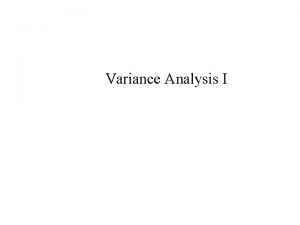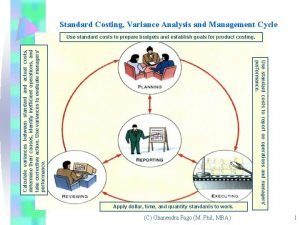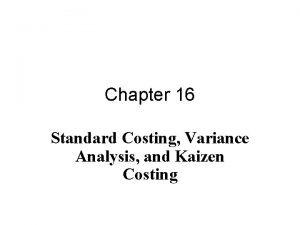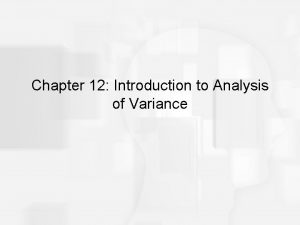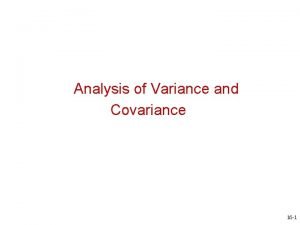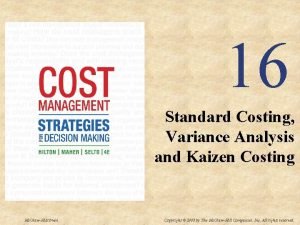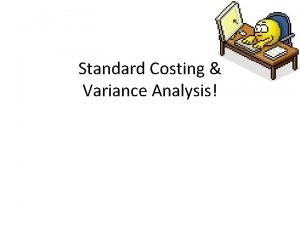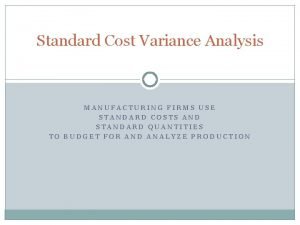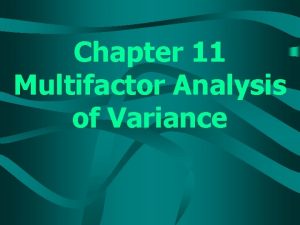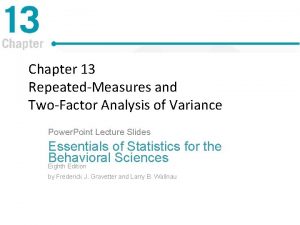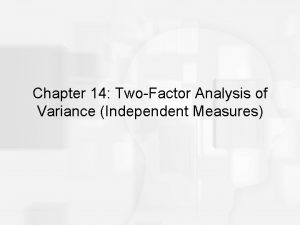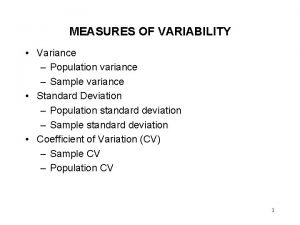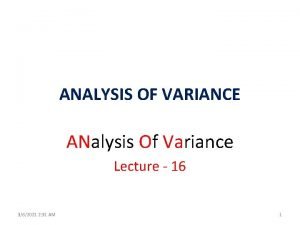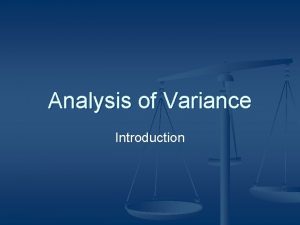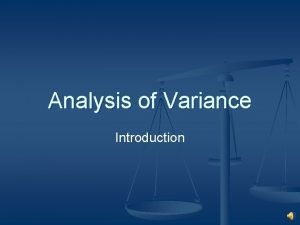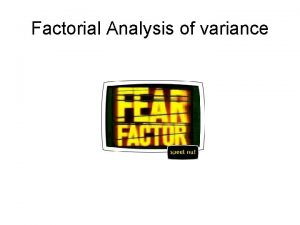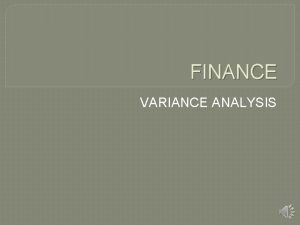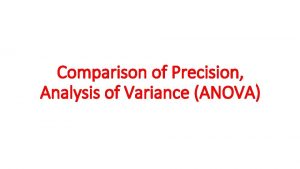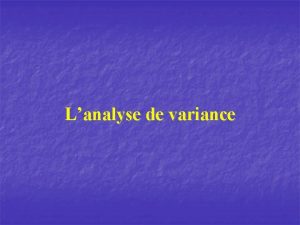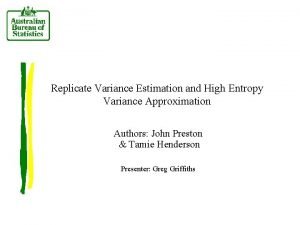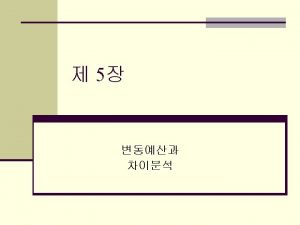Lecture 15 TwoFactor Analysis of Variance Chapter 15



























- Slides: 27

Lecture 15 • Two-Factor Analysis of Variance (Chapter 15. 5)

Oneway Analysis of Sales By Strategy Comparisons for all pairs using Tukey-Kramer HSD Abs(Dif)-LSD Quality Price Conv. Quality -71. 768 -27. 418 3. 682 Price -27. 418 -71. 76 -40. 668 Conven. 3. 682 -40. 668 -71. 768 Positive values show pairs of means that are significantly different.

Randomized Blocks ANOVA - Example Treatments Blocks b-1 K-1 MST / MSEMSB / MSE Conclusion: At 5% significance level there is sufficient evide to infer that the mean “cholesterol reduction” gained by at leas two drugs are different.

15. 5 Two-Factor Analysis of Variance • Example 15. 3 – Suppose in Example 15. 1, two factors are to be examined: • The effects of the marketing strategy on sales. – Emphasis on convenience – Emphasis on quality – Emphasis on price • The effects of the selected media on sales. – Advertise on TV – Advertise in newspapers

Attempting one-way ANOVA • Solution – We may attempt to analyze combinations of levels, one from each factor using one-way ANOVA. – The treatments will be: • • Treatment 1: Emphasize convenience and advertise in TV Treatment 2: Emphasize convenience and advertise in newspapers …………………………………. Treatment 6: Emphasize price and advertise in newspapers

Attempting one-way ANOVA • Solution – The hypotheses tested are: H 0: m 1= m 2= m 3= m 4= m 5= m 6 H 1: At least two means differ.

Attempting one-way ANOVA • Solution – In each one of six cities sales are recorded for ten weeks. – In each city a different combination of marketing emphasis and media usage is employed. City 1 Convnce TV City 2 City 3 City 4 Convnce Paper Quality TV Quality Paper City 5 City 6 Price TV Price Paper

Attempting one-way ANOVA • Solution City 1 Convnce Price TV Paper City 2 City 6 Convnce Paper City 3 Quality TV City 4 City 5 Quality Paper Xm 15 -03 Price TV • The p-value =. 0452. • We conclude that there is evidence that differences exist in the mean weekly sales among the six cities

Interesting questions – no answers • These result raises some questions: – Are the differences in sales caused by the different marketing strategies? – Are the differences in sales caused by the different media used for advertising? – Are there combinations of marketing strategy and media that interact to affect the weekly sales?

Two-way ANOVA (two factors) • The current experimental design cannot provide answers to these questions. • A new experimental design is needed.

Two-way ANOVA (two factors) Factor B: Advertising media Factor A: Marketing strategy Convenience Quality Price TV Newspapers City 1 sales City 3 sales City 5 sales City 2 sales City 4 sales City 6 sales Are there differences in the mean sales caused by different marketing strategies?

Two-way ANOVA (two factors) Test whether mean sales of “Convenience”, “Quality”, and “Price” significantly differ from one another. H 0: m. Conv. = m. Quality = m. Price H 1: At least two means differ Calculations are based on the sum o square for factor A SS(A)

Two-way ANOVA (two factors) Factor B: Advertising media Factor A: Marketing strategy Convenience Quality Price City 1 sales City 3 sales City 5 sales City 2 sales City 4 sales City 6 sales TV Newspapers Are there differences in the mean sales caused by different advertising media?

Two-way ANOVA (two factors) Test whether mean sales of the “TV”, and “Newspap significantly differ from one another. H 0: m. TV = m. Newspapers. Calculations are based on the sum of square for factor B H 1: The means differ SS(B)

Factor B: Advertising media Two-way ANOVA (two factors) Factor A: Marketing strategy Convenience Quality Price TV Newspapers City 1 sales City 3 sales City 5 sales City 2 sales City 4 sales City 6 sales Are there differences in the mean sales caused by interaction between marketing strategy and advertising medium?

Two-way ANOVA (two factors) Test whether mean sales of certain cells are different than the level expected. Calculation are based on the sum of square for interaction SS(AB)

Difference between the levels of factor A, and Difference between the levels of factor A difference between the levels of factor B; Nonodifference between the levels of fact interaction R Level 1 of factor B M Level 1 and 2 of factor B e e s p Level 2 of factor B a n o n s e Levels of factor A M R e e s a p n o n s e 1 M R e e s a p n o n s e 2 3 1 M R e e No difference between the levels of factor s. A. Difference between the levels of factor a. B p n o n s e Levels of factor A 1 2 3 Interaction 2 Levels of factor A 3

Sums of squares

F tests for the Two-way ANOVA • Test for the difference between the levels of the main factors A and B SS(A)/(a-1) MS(B) MS(A) F= F= MSE Rejection region: F > Fa, a-1 , n-ab F> Fa, b-1, n-ab SS(B)/(b-1) SSE/(n-ab) • Test for interaction between factors A and MS(AB) B SS(AB)/(a-1)(b-1) F= Rejection region: 1), n-ab MSE F > Fa, (a-1)(b-

Required conditions: 1. The response distributions is normal 2. The treatment variances are equal. 3. The samples are independent random samples.

F tests for the Two-way ANOVA • Example 15. 3 – continued( Xm 15 -03)

F tests for the Two-way ANOVA • Example 15. 3 – continued – Test of the difference in mean sales between the three marketing strategies H 0: mconv. = mquality = mprice H 1: At least two mean sales are different Factor A Marketing strategies

F tests for the Two-way ANOVA • Example 15. 3 – continued – Test of the difference in mean sales between the three marketing strategies H 0: mconv. = mquality = mprice H 1: At least two mean sales are different MS(A)/MSE F = MS(Marketing strategy)/MSE = 5. 33 Fcritical = Fa, a-1, n-ab = F. 05, 3 -1, 60 -(3)(2) = 3. 17; (p-value =. 0077) – At 5% significance level there is evidence to infer that differences in weekly sales exist among the marketing strategies.

F tests for the Two-way ANOVA • Example 15. 3 - continued – Test of the difference in mean sales between the two advertising media H 0: m. TV. = m. Nespaper H 1: The two mean sales differ Factor B = Advertising media

F tests for the Two-way ANOVA • Example 15. 3 - continued – Test of the difference in mean sales between the two advertising media H 0: m. TV. = m. Nespaper H 1: The two mean sales differ MS(B)/MSE F = MS(Media)/MSE = 1. 42 Fcritical = Fa, a-1, n-ab = F. 05, 2 -1, 60 -(3)(2) = 4. 02 (p-value =. 2387) – At 5% significance level there is insufficient evidence to infer that differences in weekly sales exist between the two advertising media.

F tests for the Two-way ANOVA • Example 15. 3 - continued – Test for interaction between factors A and B H 0: m. TV*conv. = m. TV*quality =…=mnewsp. *price H 1: At least two means differ Interaction AB = Marketing*Media

F tests for the Two-way ANOVA • Example 15. 3 - continued – Test for interaction between factor A and B H 0: m. TV*conv. = m. TV*quality =…=mnewsp. *price H 1: At least two means differ MS(AB)/MSE F = MS(Marketing*Media)/MSE =. 09 Fcritical = Fa, (a-1)(b-1), n-ab = F. 05, (3 -1)(2 -1), 60 -(3)(2) = 3. 17 (p-value=. 9171) – At 5% significance level there is insufficient evidence to infer that the two factors interact to affect the mean weekly sales.
 Twofactor authentication
Twofactor authentication Rsq in standard costing
Rsq in standard costing 01:640:244 lecture notes - lecture 15: plat, idah, farad
01:640:244 lecture notes - lecture 15: plat, idah, farad Budget variance analysis
Budget variance analysis Variance analysis cycle
Variance analysis cycle What is a static budget
What is a static budget Standard costing formula
Standard costing formula Manova definition
Manova definition Variance analysis
Variance analysis Multivariate analysis of variance and covariance
Multivariate analysis of variance and covariance The formula for usage variance is (aq - sq) * sp.
The formula for usage variance is (aq - sq) * sp. Standard costing meaning
Standard costing meaning Spss mixed model
Spss mixed model Variance analysis in nursing
Variance analysis in nursing Flexible budgets and variance analysis
Flexible budgets and variance analysis Introduction to analysis of variance
Introduction to analysis of variance Analysis of variance and covariance
Analysis of variance and covariance Kaizen costing
Kaizen costing Job cost analysis
Job cost analysis Dawson toys ltd
Dawson toys ltd Variance accounting meaning
Variance accounting meaning Analysis of variance
Analysis of variance Exploratory data analysis lecture notes
Exploratory data analysis lecture notes Sensitivity analysis lecture notes
Sensitivity analysis lecture notes Factor analysis lecture notes
Factor analysis lecture notes Analysis of algorithms lecture notes
Analysis of algorithms lecture notes Tiu lecture notes medical analysis
Tiu lecture notes medical analysis Zline 667-36
Zline 667-36
